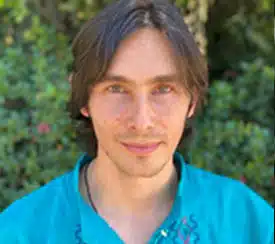
This is how we must journey for destiny, because if we disturb the ripples of time, there will be an immediate backlash. The Greeks would have said that we “anger the fates,” while the Hindus would say that we “fall into karma.” So when we journey for destiny, we can’t leave any tracks or interject our will. In order to tread lightly, we must dissolve the self, freeing ourselves from the whims of ego. We must let go of our “I” and become one with Spirit.
When we take ourselves out of the equation, when we’re no longer “doing” anything or willing an outcome, when we no longer have our hearts set on anything being different from the way it is right now, we are one with Spirit and we can simply let it happen. It is in this egoless state, accepting the world exactly as it is, that we can influence the future by tracking along our time lines.
A time line is an imaginal cord of light reaching from the present into the past and future. All the events of our history are recorded in our time lines from past to present, because every action leaves a track in time. Our time lines also extend forward into the future as thousands of luminous strands, like fiber-optic threads that fan out of the cord of light, with each strand representing a possible future. You can track forward along your possible futures to discover your healed destiny, where your heart disease or breast cancer has been cured, your diet has changed, and your toxic relationships have been cleaned up.
Tracking along time lines has been used for millennia. In aboriginal societies, the shaman needs to lead her tribe to where the fish and game are going to be the following morning. She does this by tracking along the time line of the village, to find where the hunters need to wait for the prey at daybreak. So when we journey for destiny, we track not only for the probable, but also for the possible, no matter how improbable. If we only track for probable destinies, we’ll never find the bison or the fish, a future healed state, or world peace. Instead, we’ll reinforce negative probable futures, because the negative outcomes we find become installed into our time lines.
In quantum physics, there’s a theory called the “Heisenberg uncertainty principle,” which says that the observer influences the outcome of events. Observe a subatomic particle, thinking it’s a wave, and it will actually become a wave; expect to see a subatomic particle in a certain location, and it will be there. We can apply this principle to our own lives by understanding that whatever destiny we track will come to pass—as seers know, all prophecies are self-fulfilling.
Putting the cart before the horse and looking at possibilities before looking at probabilities is essential when tracking destiny. In a televised broadcast in 1961, for example, President John F. Kennedy announced that by the end of the decade, America would land a man on the moon and return him safely to Earth. His advisers came back and said, “We don’t have the technology, the know-how, or the money.” Kennedy responded, “Make it happen.” He voiced the possible, and it happened.
Similarly, Nelson Mandela was able to manifest a collective dream of the possible, bringing about extraordinary change, against all odds. He transformed the division and hostility of apartheid into positive change and peaceful transition, with equality for all. Together, he and the people of South Africa achieved the most unlikely of destinies. If a few great men and women can change the fate of nations, imagine how much easier it is to change our individual fates.
Next week: The Momentum Channel.
.







